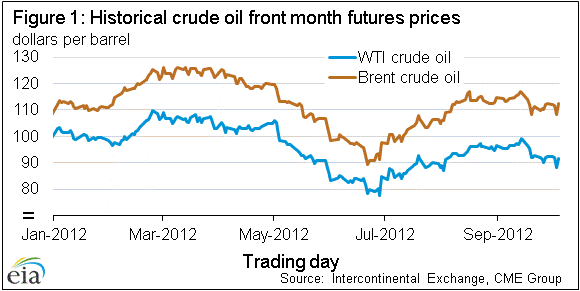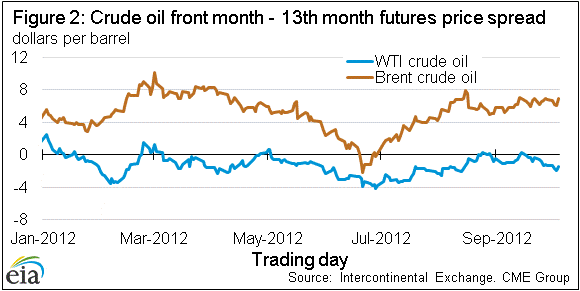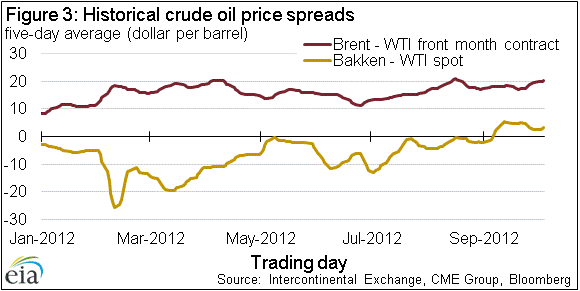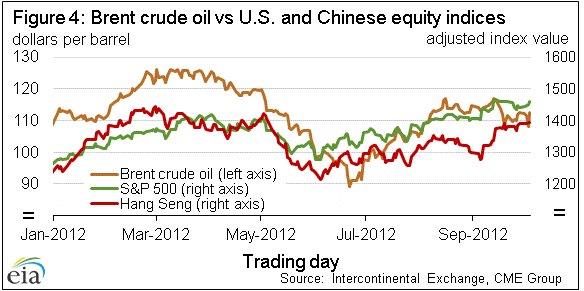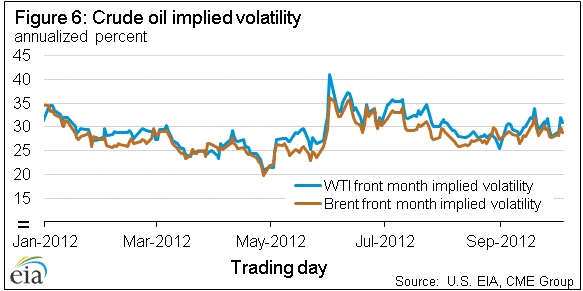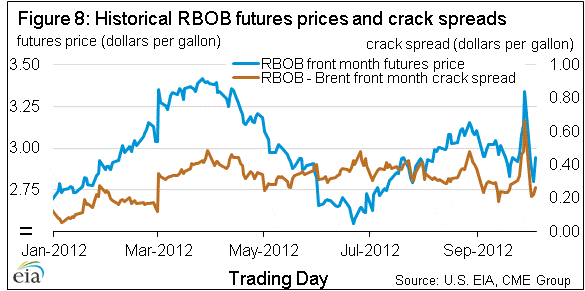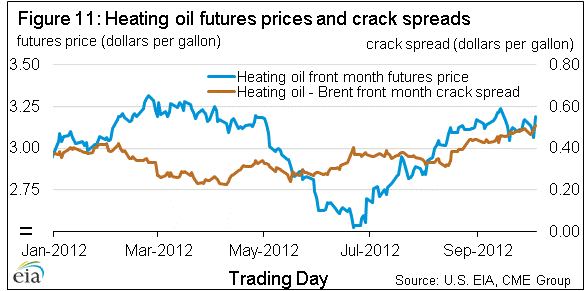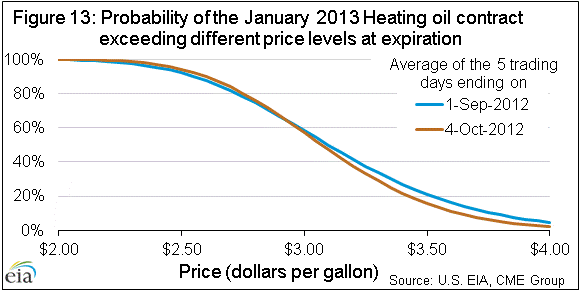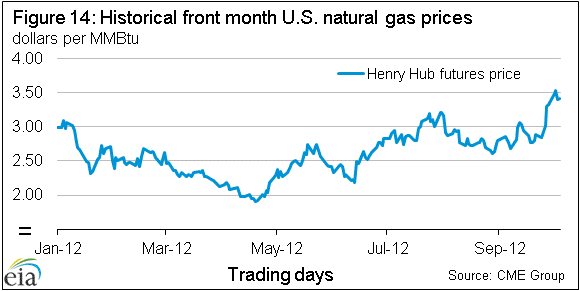Short-Term Energy and Winter Fuels Outlook
Release Date: October 10, 2012 | Next Release Date: November 6, 2012 | Full Report | Text Only | All Tables | All Figures
Market Prices and Uncertainty Report
This is a regular monthly supplement to the EIA Short-Term Energy Outlook.
Contact: James Preciado (James.Preciado@eia.gov)
Full Report
Crude Oil Prices
Prices: Crude oil prices reached their highest levels since May by the middle of September, but then declined and were lower at the end of the month than at the beginning. The Brent and WTI crude oil futures prices settled at $112.58 and $91.71 per barrel, respectively, on October 4, down $1.60 and $3.59 per barrel, respectively, from September 4 (Figure 1).
Markets rose early in September after the European Central Bank (ECB) announced an unlimited bond-purchase program, the Chinese government presented plans for $157 billion in infrastructure development, and the U.S. Federal Reserve announced that it would start buying $40 billion each month in mortgage-backed securities. Oil prices, however, pulled back quickly in mid-September, falling more than $8 per barrel in three days. Reports of increased production in Saudi Arabia and statements suggesting that it preferred lower prices were accompanied by a sudden drop in futures prices. In addition, some disappointing economic news implied slower economic growth, particularly in China, and concerns that the European debt crisis would continue to hinder economic growth despite the additional stimulus measures. Brent and WTI prices moved in a relatively narrow trading range over the subsequent two weeks.
Reports of additional delays of October loadings of North Sea crude oil due to maintenance continued into late September, which, combined with September loadings that were the lowest in 5 years, contributed to a moderate increase in backwardation in the Brent futures curve. The 1st-13th Brent time spreads increased from $5.89 per barrel on September 4 to $6.98 per barrel on October 4 (Figure 2).
The tightness in the near-term Brent market contrasted with a WTI market where transportation constraints continued and crude oil inventories at Cushing, Oklahoma, remained well above prior-year levels and 5-year averages. This resulted in a modest widening of the Brent-WTI price spread, from $18.88 per barrel on September 4 to $20.10 per barrel on October 4 (Figure 3). However, transportation bottlenecks in the Bakken region eased as reports of additional rail loadings of Bakken crude moving both east and west helped to push the Bakken-WTI price spread into positive territory for the first time since November 2011. Bakken sold at a $10 per barrel discount to WTI as recently as July.
Crude Oil and Equity Markets: Expectations of additional stimulus from the ECB, the Chinese government, and the Federal Reserve contributed to rising equity markets in the first half of September, a period during which oil prices also rose. Equity indices leveled off but remained at high levels through the rest of the month. The S&P 500 closed 4 percent higher on October 4 compared to September 4, while the Hang Seng was 7.6 percent higher during the same period (Figure 4). Thus, the equity indices did not show the same decline that occurred in oil prices in mid-September, which may be an indication that the oil market was largely responding to positive supply side information. Crude Oil and Inflation Expectations: Investments in crude oil and other commodities are often viewed as hedges against inflation. Crude oil prices have shown a tendency to move with expectations of inflation (Figure 5), measured here as the difference between the 5-year Treasury bond yields and Treasury Inflation-Protected Securities (TIPS). The effect, however, runs both directions. Oil prices factor into many aspects of the economy. When oil prices rise, expectations of inflation also increase. (For a further discussion of the effect of oil prices on inflation, see Increases in oil prices affect broader measures of inflation). Volatility: Crude oil implied volatility changed little over the past month. Implied volatility for the front month Brent futures contract settled at 29 percent on October 4, nearly identical to that on September 4. WTI implied volatility increased by less than one percentage point from September 4 to 31 percent on October 4. These volatility measures use the prices of at-the-money call options to calculate implied volatility (Figure 6).Market Derived Probabilities: The probability of the January 2013 WTI futures contract expiring above $100 per barrel is now 26 percent, a 13 percent decrease from the five-day period ending September 1 (Figure 7). Since implied volatility was nearly unchanged, the decrease in price had the largest effect on the decreased probability of exceeding $100 per barrel at expiration compared to market conditions on September 1. Given the higher level of Brent prices relative to WTI prices, the probabilities that the January Brent contract will exceed specified dollar thresholds are higher.
Gasoline
Prices: Gasoline futures prices for delivery in New York Harbor increased slightly during the first week of September, prompted in large part by a decrease in U.S gasoline inventories. U.S. gasoline inventories for the week ending August 31 dropped below 200 million barrels for the first time since 2008. Prices subsequently declined until the last week of September as demand weakened with the end of the driving season. During the last week of September, a variety of factors put upward pressure on the front month futures price. Both planned and unplanned refinery outages raised concerns about near-term supplies. The physical supply of gasoline in the delivery area of the futures contract was limited due to pipeline capacity constraints. Market participants caught short at contract expiration had to buy in a thin market, resulting in an unusual spike in prices. Prices for the October contract jumped from $2.92 per gallon on September 24 to $3.34 per gallon on the day of its expiration, September 28. With the roll to the November contract, the front month futures price came back down during the first week of October, settling at $2.94 per gallon on October 4 (Figure 8). The RBOB – Brent front month crack spread was $0.23 per gallon on September 4. It jumped to $0.67 per gallon with the price spike on September 28, and then returned to $0.26 on October 4.
Volatility: Historical volatility for the front month RBOB futures contract increased substantially during September, having been affected by the significant price increases at the end of the month. Historical volatility more than doubled between September 4 and October 4, rising from 27 to 55 percent. Implied volatility, which remained relatively flat this month, settled at 32 percent on October 4, a slight increase from the September 4 level of 30 percent (Figure 9). Apparently, the factors that drove up gasoline futures prices during the last week in September did not substantially increase the uncertainty surrounding future gasoline prices.
Market Derived Probabilities: The January 2013 RBOB futures contract averaged $2.71 for the five trading days ending October 4 and has a probability of exceeding $2.85 per gallon ($3.50 retail) at expiration of approximately 34 percent. The same contract as of the five trading days ending September 1 had a probability of exceeding $3.50 retail of 39 percent. The tightness in the gasoline market that contributed to higher RBOB futures prices at the end of the September did not increase the probability of the January contract exceeding given price levels. In fact, recent lower crude oil and RBOB futures prices contributed to a slightly decreased probability of the January contract exceeding given price levels when compared to market conditions on September 1 (Figure 10).
Heating oil
Prices: Heating oil prices followed the general pattern of crude oil prices, rising in the first half of September, and then falling off quickly before slowly moving higher over the last two weeks. The front month heating oil futures contract settled at $3.19 per gallon on October 4, an increase of 4 cents per gallon from September 4 (Figure 11). While following the general pattern of crude oil, heating oil prices rose more and fell less, with the heating oil – Brent crack spread widening to $0.51 per gallon on October 4, the highest since November 2008. Tight distillate markets contributed to the rising crack spread. Distillate inventories in the Northeast for the week ending September 28 were about 40 percent below the 5-year average.Volatility: Heating oil implied volatility remained below Brent but generally followed the same pattern, drifting lower after a brief rise in the middle of the September. Heating oil implied volatility was 24 percent on October 4, up slightly from September 4 (Figure 12).
Market Derived Probabilities: Heating oil futures contracts for January 2013 delivery averaged $3.10 per gallon for the five days ending October 4, down almost $0.04 from September 1, and has a probability of exceeding $3.50 per gallon at expiration of approximately 15 percent. The same contract as of the five trading days ending September 1 had a probability of exceeding $3.50 of 21 percent. Lower prices along with shorter time to expiration days were the main contributors to the decrease in probability of the January contract exceeding $3.50 per gallon (Figure 13).Natural Gas
Prices: The front month NYMEX futures contract price for delivery of natural gas to Henry Hub in Louisiana rose swiftly during the month of September and early October, likely on forecasts of cooler weather for fall and winter compared to last year. The front month futures contract settled at $3.41 per MMbtu on October 4, $0.56 per MMBtu above prices on September 4, but $0.23 per MMBtu lower than this time last year (Figure 14). Natural gas storage is still 8.3 percent above the 5 year average as of October 4th, a continuing vestige of the very high storage levels seen all year, but concerns about limited storage capacity appear to have eased during September and early October. Weekly storage injections have remained relatively in line with forecasts since September 4, contributing less to price fluctuations than in previous months.The spread between the Transco NY Zone 6 and Henry Hub front month futures curve is relatively narrow this month compared to its year-ago level, indicating market expectations for a relatively loose regional natural gas market in the coming months (Figure15). The spread for the November 2012 contract fell 47 percent from this time last year, settling at $0.28 per MMbtu on October 4. The spread remains significantly smaller than last year all the way through March 2013, with January 2013 and February 2013 shrinking 26 and 33 percent respectively, though this year's spread is still wider than in 2010. In previous years, the New York market would probably have been similar to the New England market, for which there is no widely quoted basis swap. However, this year has seen greater tightness in New England, partly as a result of lower liquefied natural gas (LNG) deliveries.
Volatility: Implied volatility for the front month futures contract has been moving steadily downwards since August 28, hitting a 10-month low of 41 percent on September 28 and settling at 42 percent on October 4. Historical volatility also moved lower until rapidly rising prices during the last week in September pushed volatility back up. The divergence since September 25 indicates that the recent volatility is not currently affecting the market's perception of future price uncertainty (Figure 16).
Market Derived Probabilities: The probability that the January 2013 contract will settle higher than $3.50 per MMBtu rose by 33 percentage points from 35 to 68 percent when compared to market conditions on the five trading days ending September 4 (Figure 17). The average price over the five trading days ending on October 4 for the January 2013 contract increased by $0.55 per MMBtu, compared to the five trading days ending September 4.Other Resources
Energy Price Volatility and Forecast Uncertainty documentation
(Adobe PDF file)
West Texas Intermediate crude oil price and NYMEX 95% confidence intervals
January 2011 - Current Month
(Adobe PDF file)
January 2009 - December 2010
(Adobe PDF file)
January 2007 - December 2008
(Adobe PDF file)
Henry Hub natural gas price and NYMEX 95% confidence intervals
January 2011 - Current Month
(Adobe PDF file)
January 2009 - December 2010
(Adobe PDF file)
January 2007 - December 2008
(Adobe PDF file)

